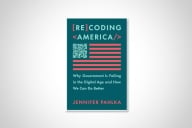You have /5 articles left.
Sign up for a free account or log in.
This piece from CNBC reminded me of the old joke about the T-shirt for the Non Sequitur Club: “We also like pizza!” In its way, the story is a remarkable ad for the Non Sequitur Club.
The headline isn’t promising: “Fewer kids are going to college because they say it costs too much.” Okay, let’s start with the word “kids.” It’s inaccurate, obviously -- we consider our students adults -- and it reflects an assumption that most students go to college directly from high school. In fact, most don’t. But leave that aside. In fairness, writers often aren’t allowed to pick their own headlines, so the author, Jessica Dickler, should get a pass on that.
It gets worse from there, though. Take these consecutive paragraphs:
“A recent survey of high school students found that the likelihood of attending a four-year school sank by nearly 20% in the last eight months -- down to 53%, from 71%, according to ECMC group, a nonprofit aimed at helping student borrowers.
“High schoolers are putting more emphasis on career training and postcollege employment, the report found.
“More than half said they can achieve professional success with three years or less of college, and just one-fourth believe that a four-year degree is the only route to a good job.”
The survey is of high school students; we’ve already established that students fresh out of high school are a minority of college students in America. By focusing only on them, we’re already getting a skewed picture. But even if we allow for the sample chosen, the evidence doesn’t support the story. The evidence cited refers specifically to four-year colleges; from that, the story asserts that students are losing interest in college altogether.
That inference only makes sense if you define “college” to exclude community colleges.
The students apparently don’t make that mistake. The scenario of three years or less of college being enough to lead to professional success sounds an awful lot like an associate degree, such as one might receive from a community college. And the students are right; as I’ve mentioned before, according to the College Scorecard, associate degree grads in nursing from Brookdale make higher salaries than bachelor’s degree grads from Princeton in English. In terms of bang for the buck, the comparison is a blowout.
But in the story, neither community colleges nor associate degrees even exist. Perhaps that’s because their dramatically lower tuition levels would contradict the thesis of the story.
If high tuition were truly driving students away, then we would have seen massive enrollment drops at the most expensive places and massive enrollment increases at the least expensive. Instead, we’re seeing application booms at exclusive places and community colleges taking the biggest hits on enrollment. The expensive places are attracting more people, and the affordable ones are attracting fewer. That’s a story in itself, but it’s not a story of colleges pricing themselves out of the market.
The story there isn’t of tuition spirals, out-of-touch academics or any of the usual suspects. It’s a story of wealth polarization. The wealthiest institutions are becoming more so, and everyone else is struggling. Ultimately, that’s not really a story about colleges; it’s really a story about the larger economy and the political choices underlying it. The fear that high school students express about employability are not mostly about tuition; they’re about an increasingly winner-take-all job market. As Tressie McMillan Cottom put it in Lower Ed, prestige degrees serve as a sort of negative social insurance. They provide the prospect of protection against economic free fall.
The community college system in the United States was born in 1901, but it really exploded in the 1960s, when the economy was at its most egalitarian. Community colleges reflected the political economy of the times in which they were built. Since then, the distribution of wealth has become much more polarized -- academics use the Gini index to trace that -- which has put community colleges (and many public four-year colleges) in an awkward spot. They were built to create a middle class for a country that no longer wants one. Or, more accurately, that no longer understands that middle classes don’t occur in nature; they have to be deliberately created through sustained policy choices.
Leaving community colleges out of the discussion of enrollment patterns is offensive on its own terms, but it also leads to a fundamental misunderstanding. Most colleges are not elite and expensive, and those that are aren’t seeing enrollment drops. Community college is college, and when we both accept that and revisit easy assumptions in light of it, the picture suddenly looks very different.
Until we get the basic terms right, we’ll never get the big story right.







